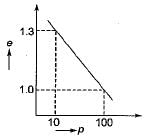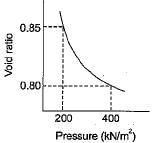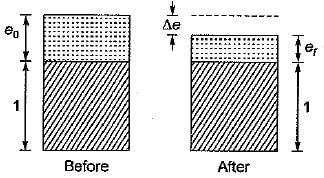Test: Compressibility & Consolidation - 1 - Civil Engineering (CE) MCQ
10 Questions MCQ Test GATE Civil Engineering (CE) 2025 Mock Test Series - Test: Compressibility & Consolidation - 1
Consider the following statements:
1. Coefficient of consolidation normally increases with decreasing liquid limit of clay.
2. The larger the value of coefficient of consolidation, the longer it takes for full consolidation to occur.
Which of these statements is/are correct?
1. Coefficient of consolidation normally increases with decreasing liquid limit of clay.
2. The larger the value of coefficient of consolidation, the longer it takes for full consolidation to occur.
Which of these statements is/are correct?
The virgin compression curve for a soil is shown in figure given below. What is the compression index of the soil?


The e-p curve for a soil is shown in the figure below. The coefficient of compressibility (in m2kN) of the soil is


The figure given shows the state of a sample of clay before and after consolidation. Based on these figures, the settlement of a clay layer of initial thickness H will be

The settlement analysis for a clay layer draining from top and bottom shows a settlement of 2.5 cm in 4 years and an ultimate settlement of 10 cm. However detailed subsurface investigation reveals that there is no drainage at the bottom. The ultimate settlement in this condition will be
Match List-I with List-II and select the correct answer using the codes given below the lists (notations have their usual meaning):
List-I
A. Coefficient of compressibility
B. Com pression index
C. Time factor
D. Coefficient of volume compressibility
List-ll
1. mv
2. Cvt / H2
3. av
4. Cc
Codes:
A B C D
(a) 3 2 4 1
(b) 1 2 4 3
(c) 1 4 2 3
(d) 3 4 2 1
The liquid limit of a saturated normally consolidated soil is 59%. The compression index of this soil for the virgin compression curve will be
Coefficient of consolidation is used to calculate
The value of a compression index for remoulded sample, whose liquid limit is 50%, is
|
31 docs|280 tests
|


























